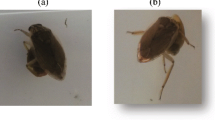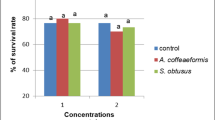Abstract
The effect of snail-conditioned water (SCW) from Biomphalaria alexandrina, a pigmented and an albino strain of B. glabrata, and Lymnaea stagnalis on the host-finding behavior of miracidia of two Brazilian and one Egyptian strain of Schistosoma mansoni was studied. Miracidia of the Egyptian strain significantly preferred their suitable host B. alexandrina versus the other snail species with their behavior patterns of host location and their responses after contact with the host. However, miracidia of both Brazilian strains did not differentiate between SCW from three of the snail species; only the pigmented B. glabrata elicited weaker responses. The releasing cues of SCW for miracidial host-finding phases are macromolecular glycoconjugates. An analysis of SCW by sodium dodecyl sulfate-polyacrylamide gel electrophoresis (SDS-PAGE), blotting, and subsequent carbohydrate detection showed that the band patterns of glycoconjugates differed significantly among the four snail strains. Therefore, differing chemical characteristics of the signaling glycoconjugates could be the basis for the observed host specificity in miracidial host-finding.
Similar content being viewed by others
References
Basch PF (1976) Parasitological review: intermediate host specificity in Schistosoma mansoni. Exp Parasitai 39:150–169
Barbosa FS, Carneiro E (1965) Penetration of Schistosoma mansoni miracidia in abnormal hosts. Rev Inst Med Trop Sao Paulo 7:99–102
Brasio BC, Magalhães LA, Miller J, Carvalho JF (1985) Atração de miracídios de Schistosoma mansoni por hospedeiros invertebrados comportamento de miracídios frente a girinos de Hylafuscovaria. Rev Saude Sao Paulo 19:18–27
Chemin E (1968) Interference with the capacity of Schistosoma mansoni miracidia to infect the molluscan host. J Parasitol 54:509–516
Chemin E (1970) Behavioral responses of miracidia of Schistosoma mansoni and other trematodes to substances emitted by snails. J Parasitol 56:287–296
Chemin E, Dunavan CA (1962) The influence of host-parasite dispersion upon the capacity of Schistosoma mansoni miracidia to infect Australorbis glabratus. Am J Trop Med Hyg 2:455–471
Chemin E, Perlstein JM (1971) Protection of snails against miracidia of Schistosoma mansoni by various aquatic invertebrates. J Parasitai 57:217–219
Combes C, Moné H (1987) Possible mechanisms of the decoy effect in Schistosoma mansoni transmission. Int J Parasitol 17:971–975
Denny M (1983) Molecular biomechanics of molluscan mucous secretions. In: Hochachka PW (ed) The Mollusca. Academic Press, New York, pp 431–65
Etges FJ, Decker CL (1963) Chemosensitivity of the miracidium of Schistosoma mansoni to Australorbis glabratus and other snails. J Parasitol 49:114–116
Files VS, Cram EB (1949) A study on the comparative susceptibility of snail vectors to strains of Schistosoma mansoni. J Parasitol 35:555–560
Haberl B, Haas W (1992) Miracidium of Schistosoma mansoni: a macromolecular glycoconjugate as signal for the behaviour after contact with the snail host. Comp Biochem Physiol [A] 101:329–333
Haberl B, Kalbe M, Fuchs H, Ströbel M, Schmalfuss G, Haas W (1995) Schistosoma mansoni and S. haematobium: miracidial host-finding behaviour is stimulated by macromolecules. Int J Parasitol 25:551–560
Haselbeck A, Hösel W (1990) Description and application of an immunological detection system for analyzing glycoproteins on blots. Glycoconjugate J 7:63–74
Kastenholz HD, Meier-Brook C (1982) The relations between Schistosoma mansoni miracidia and a lymnaeid snail. Malacologia 22:77–80
Kyhse-Anderson J (1984) Electroblotting of multiple gels: a simple apparatus without buffer tank for rapid transfer of proteins from polyacrylamide to nitrocellulose. J Biochem Biophys Methods 10:203–209
Laracuente A, Brown RA, Jobin W (1979) Comparison of four species of snails as potential decoys to intercept schistosome miracidia. Am J Trop Med Hyg 28:99–105
Maclnnis AJ (1965) Responses of Schistosoma mansoni miracidia to chemical attractants. J Parasitol 51:731–746
Malek EA, Malek RR (1978) Potential biological control of schistosomiasis intermediate hosts by helisome snails. Nautilus 92:15–18
Meier-Brook C (1978) Calcium uptake by Marisa cornuarietis (Gastropoda; Ampulariidae), a predator of schistosome-bearing snails. Arch Hydrobiol 82:449–464
Michelson EH (1986) Preliminary observations on a hemolymph factor influencing the infectivity of Schistosoma mansoni miracidia. Acta Trop (Basel) 43:63–68
Moné H, Combes C (1986) Analyse expérimentale de l’effect “decoy” (ou effet leurre) exercé par les mollusques non cibles sur le systéme hôte-parasite Biomphalaria glabrata (Say, 1818) — Schistosoma mansoni Sambon, 1907. Acta Oecol Oecol Appl 7:281–286
Plempel M, Gönnert R, Federmann M (1966) Versuche zur Wirts-findung von Miracidien. Proc Int Congr Parasitol 1:32
Poduslo JF (1981) Glycoprotein molecular-weight estimation using sodium dodecyl sulphate-pore gradient electrophoresis: comparison of TRIS-glycine and TRIS-borate-EDTA buffer systems. Anal Biochem 114:131–139
Saladin KS (1979) Behavioral parasitology and perspectives on miracidial host-finding. Z Parasitenkd 60:197–210
Shiff CJ (1974) Seasonal factors influencing the location of Bulinus (Physopsis) globosus by miracidia of Schistosoma haematobium in nature. J Parasitol 60:578–583
Spiro RG (1966) Analysis of sugars found in glycoproteins. In: Neufeld EF, Ginsburg V (eds) Methods in enzymology, vol VIII. Academic Press, New York, pp 3–26
Takahashi T, Mori K, Shigeta Y (1961) Phototactic, thermotactic and geotactic responses of miracidia of Schistosoma japonicum. Jpn J Parasitol 6:686–691
Upatham ES (1972) Interference by unsusceptible aquatic animals with the capacity of the miracidia of Schistosoma mansoni Sambon to infect Biomphalaria glabrata (Say) under field-simulated conditions in St. Lucia, West Indies. J Helminthol 46:277–283
Webbe G, James C (1971) The importation and maintenance of schistosomes of medical and veterinary importance. In: Taylor AER, Muller R (eds) Isolation and maintenance of parasites in vivo. Symposia of the British Society for Parasitology, vol 9. Blackwell, Oxford, pp 77–107
Wright CA (1964) Miracidial responses to molluscan stimuli. Proc Int Congr Parasitol 2:1058–1059
Author information
Authors and Affiliations
Rights and permissions
About this article
Cite this article
Kalbe, M., Haberl, B. & Haas, W. Schistosoma mansoni miracidial host-finding: Species specificity of an Egyptian strain. Parasitol Res 82, 8–13 (1996). https://doi.org/10.1007/s004360050059
Received:
Accepted:
Issue Date:
DOI: https://doi.org/10.1007/s004360050059




